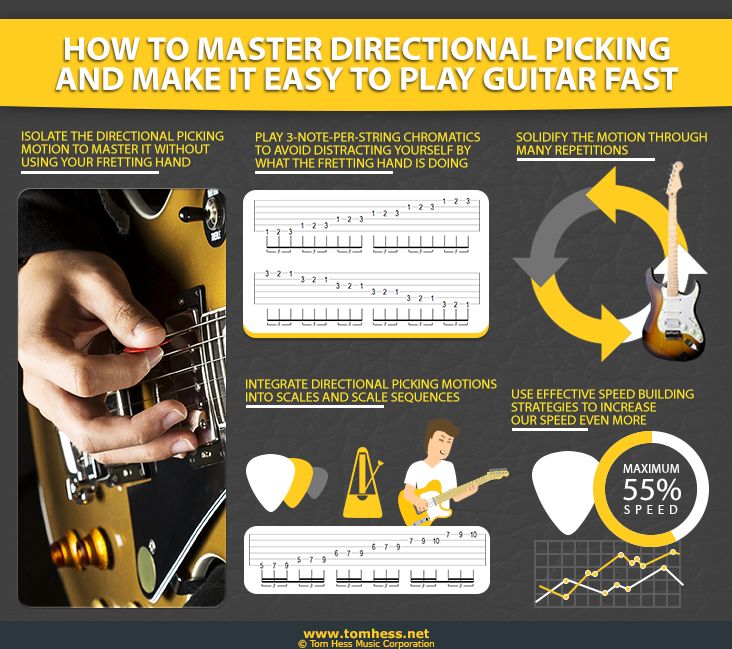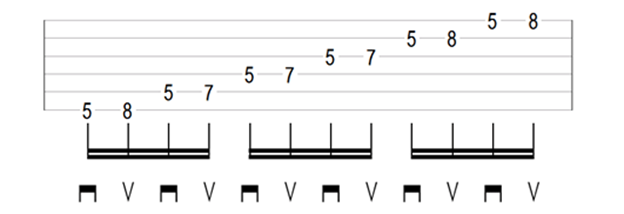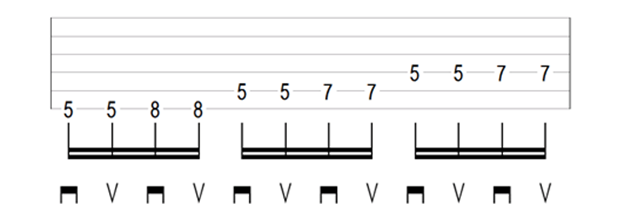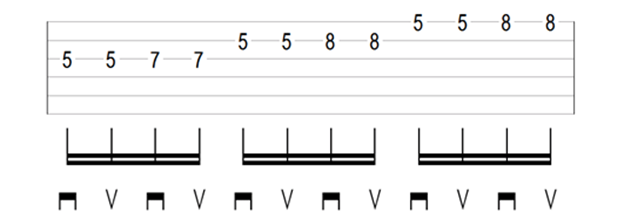This Simple Trick Makes Fast Guitar Playing Much Easier
When are you most likely to make mistakes in your guitar playing?
Is it while playing something fast only one time?
Or is it when you are playing something over and over again many times?
The answer is obvious.
This is exactly why it’s harder to play a long stream of notes fast than to play shorter licks.
And it’s why you often play longer runs at slower tempos.
That said …
You can easily increase your consistency of playing faster licks over and over.
All it takes is knowing what to do, how to do it and then doing it.
Check out this video where I show you some of my favorite ways to make your playing more consistent at higher speeds:
Click on the video to begin watching it.
See my other instructional guitar videos, available to my YouTube subscribers - follow my channel by clicking the button below:
Are there other ways to make your fast guitar playing more accurate and reliable at higher speeds?
You bet!
Here are some of the most important ones:
Guitar Speed Consistency Element #1: Efficiency
Here are the most important elements of technical efficiency to focus on:
- Directional picking
Directional picking is 33% more efficient than pure alternate picking. And anyone serious about achieving maximum speed in minimum time should be picking this way.
Here is how it works:
When you pick on a single string – use strict alternate picking.
And when you move to a higher in pitch string, use a downstroke to change strings. When you move to a lower in pitch string – use an upstroke to change strings.
This way you’ll always be using the shortest, most efficient motion to get to the next note.
Question: “But Tom Hess, this doesn't work for 2-note-per-string licks or pentatonic scales!”
Answer: Yes it does. Read the above description of directional picking again. You always ascend to the next higher string with a downstroke, no matter if the previous string was played with an up or a downstroke.
And sometimes, this means you can use sweep picking to change strings. (Like when you play 3-note-per-string scales or 1-note-per-string arpeggios.)
Other times, you have no choice but to alternate pick on the string change. (Like when playing 2-note-per-string scales for example.)
But in both cases you use the most direct path to the next string. Hence the name: directional picking.
Question: “Tom Hess, I'm having a hard time doing directional picking on 3-note-per-string scales. It doesn't sound like triplets – it sounds a galloping rhythm. How do I fix this?”
Answer: Isolate the picking hand motions. Play them without using your fretting hand at all. (I demonstrate how in this guitar picking video.)
Then you can fully focus on doing the correct rhythm with your picking hand.
Note: do not stop the pick between strings.
After you play the 3 notes on the low E string, the pick should fall onto the A string using momentum from the last note on the low E string.
If you stop between the low E string and the A string, you will defeat the biggest advantage directional picking has over alternate picking.

Moving on – the next element of guitar technique efficiency is:
- 2- hand synchronization.
There are 2 types of guitar speed: Potential speed & usable speed.
Potential guitar speed is how fast your hands can theoretically move, in isolation.
Usable guitar speed is the speed at which you can keep your hands perfectly in sync and make sure the notes are clean and accurate.
Your usable speed (the speed of keeping your hands in sync) is the only speed that really counts.
And is the only speed you want anyone to actually hear.
The better your 2-hand synchronization, the higher your usable speed and the easier it is to be consistent during fast playing.
Here are some of the best ways to build your 2-hand synchronization top speed:
1. Double picking.
Like the name implies, play your scales and scale sequences by picking every note two times.
For example:
Example (regular scale):

Double-picked scale:


How does double picking help you?
Simple:
Picking every note 2 times makes your 2-hand synchronization more difficult.
Your picking hand is forced to move twice as fast as the fretting hand.
This makes it hard to articulate every note clearly and makes any mistake more obvious.
When you go back to normal playing, your picking feels much easier and your 2-hand synchronization becomes much tighter.
2. Practice unplugged.
This forces you to articulate the notes with more power and trains your articulation. And the stronger your articulation is, the tighter your synchronization.
That’s because it’s impossible to play with powerful pick attack and NOT be in sync when you do it.
Spend 5-10 minutes per day working on tightening up your synchronization. You will be glad you did.
The next element of consistency during fast playing?
- Excess muscle tension control
Excess tension is the silent killer of your guitar technique.
And the best way to fight it is to do a tension audit of your entire body when you play.
What is a tension audit?
It means rotating your attention from: your jaw, your shoulders, your upper arms, your lower arms, your wrists, your stomach, your thighs, your calves and your feet…
… and relaxing them as you play.
Question: “But Tom Hess, how is it possible to focus on all of these parts of my body at once?”
Answer: You don’t focus on all of them at once, you focus on them one at a time. Like this:
Focus on relaxing your jaw for 3 receptions of the exercise. Then focus on your shoulders for 3 repetitions.
Then… (you guessed it), relax your upper arms for 3 repetitions. And so on.
Keep going like this – rotating your focus from one body part to another, relaxing it. Before you know it, you’ll be playing without excess tension all the time.
This guitar technique video shows this process in more detail.
Guitar Speed Consistency Element #2: Integration
One reason why long passages are hard to play fast…
… is because they often require you to integrate (combine) 2 or more techniques.
So, when you practice, you should practice integrating (combining) a variety of guitar techniques.
For example:
- Combine scale sequences with arpeggios (and vice versa)
- Combine power chords with lead guitar licks (and play in time)
- Combine string skipping licks with bent-note vibrato
Etc.
The more integration practice you do – the more consistency you develop in our guitar playing in genera (and at higher speeds).
Question:” But Tom Hess, there are dozens of techniques and millions of possible combinations of them! How is it even possible to ever integrate all of them?”
Answer: The good news is: you don’t have to master integrating all techniques that exist in all their combinations. Simply chip away at integration as a general skill. Get better at it week by week little by little.
As you do – your consistency, your accuracy and your speed will continue to increase.
Guitar Speed Consistency Element #3: Your mindset
Here is something quite ironic:
The less pressure you put on yourself to be consistent and play perfectly…
… the better you play.
How to best develop this mindset in your guitar playing?
Simply don’t expect to ever play perfectly. Accept that, as a human, you will make some mistakes when you try to push yourself to play at a high level.
Ironically, you will play a heck of a lot better with this mindset, than if you put pressure on yourself to play without any mistakes.
You now know how to make your guitar playing more consistent at higher speeds. The next step is to transform the rest of your guitar playing, so you become the guitar player you always wished you could be.
I can help you with this inside my Breakthrough Guitar Lessons.
Here is how it works:
Tell me about your musical goals and guitar playing challenges. And I’ll create a customized lesson plan to get you playing guitar the way you want.
Plus: I’ll track your progress, give you feedback on your guitar playing and hold your hand every step of the way to nearly guarantee your results.
Here is what my guitar students are saying:
“My experience with the Breakthrough Guitar Lessons has been really good. I can tell that I've made a lot of progress.”
In previous lessons that I had with other instructors, the lessons were never really clear. It was more like, you know, come in, bring in some music, let's learn how to play your favorite songs... it wasn't about becoming a musician. With Tom and the Breakthrough Guitar Lessons, I'm noticing that I'm just learning so much more about music in general and I don't really worry about covering other people's music, I'm just sitting there and belting out whatever I'm feeling.
It's been a HUGE growth experience.
Jason Harrington, Illinois, USA
“July of 2012, I had been managing in a retail store and was kind of reaching this point where I was really getting frustrated because I had been struggling to progress in my guitar playing. I had this mindset that I had to teach myself everything... you know and the best players are all self taught and stuff like that...”
...and I remembered Tom Hess from that book, and I said “You know, it’s time to look this guy up and see what he’s all about.” And it didn’t take me very long to figure out that this is the kind of person that I needed to get on board with.
My playing has definitely improved technique-wise, but probably the most important change I have experienced is just in my overall mindset as a player and as a practicing musician. I just feel like I have a much better frame of mind and a much better idea of where I am going and where my guitar practicing is taking me. Whereas before I just felt like I had to practice everything and I had a whole bunch of stuff going on. It’s a lot more focused now.
Being in the environment that Tom has created with his other students is incredibly motivating. I had always been in my own little shell, kind of just stayed on my own. Coming out here... like when I came out here last year was a big step out of my comfort zone. Getting around all these other musicians... it’s unbelievable how great some of these guys are, not just as players, but as people.
Andrew Tintle, Richmond, California USA
“When I first heard about Tom Hess, I saw that he was a teacher that was very dedicated and serious about it, and that drew me in immediately. That this is a guy that has a plan, has a goal and really if you’re serious about learning guitar, this guy is equally as serious in a way. So it resonated with me straight away.”
I started out just learning by myself and as many others I got stuck. I had a few issues I wanted to get by, but when I met Tom and talked with him and started lessons with him, he opened up a whole new world of possibilities of what guitar playing can be.
I feel very grateful that I found lessons from Tom since I then did what worked from the very beginning. Many guitarists I see that played way longer than I did, they have build up many bad habits. That from the very start, there was clear instruction of how to practice correctly. You build the ability for high speed and whatever you want from the very beginning and you don’t waste time doing inefficient things. So I’m very grateful that I did that, and now I really feel I am able to reach whatever level I want.
The reasons why I think I feel so motivated all the time is because I know that the thing I’m working on is relevant for me and it’s exactly the direct thing I need to get.
The forum just kicks ass. The people in the forum - it’s just like unconditional help all the time. They love to help out, and you also get very inspired by seeing someone just really getting speed really quick and then you say if he can do it, I can do it. It works on the mental side of being a guitarist and that of course that’s the most important thing. Just being around other musicians like that, is just you learn so much faster, is so much less frustration when you can see that all the people are having the same issues that you do, not anything special or anything. It’s just part of learning process, so it kicks ass.
Magnus Gautestad, Norway
“I wasn't really at the level I wanted to be at, and I didn't really know how to get there, and Tom just showed me the way, how to get to that level, how to practice properly, how to improve.”
Tom is a great teacher, he knows what he is talking about and he doesn't just, like a lot of other guitar teachers, teach songs. Tom tells me what to practice, what's good for me to practice. There is a lot of free stuff on the internet, but there is nobody really telling you what to do, what's good for you, and that's what Tom is great at. Tom just knows so much about teaching, he knows how to deal with all the problems. Other teachers are not able to help me in the way that Tom does.
Ike Biedermann, Guitar Teacher, Leipzig, Germany
To begin transforming your guitar playing like my top students did, go here: https://tomhess.net/Guitar


